Wow, looks like I might have to bump this up the list of games I want to get this year. I didn't expect it to turn out this well.
Mario & Luigi: Bowser's Inside Story Review
|
|
See PixlBit's Review Policies

On 10/31/2009 at 01:57 PM by Chessa DiMola Bowser and the Bros. unintentionally team up for one of the best iterations in the Mario RPG series. |

If you are a Mario fan, RPG fan, DS owner, or like having fun, you should get up this instant and go buy the game.
Mario & Luigi Bowser's Inside Story is the latest Mario RPG title, and as someone who has spent hours with each previous game, I was skeptical that this title could deliver a standout experience from what had already been offered. While I knew I was in for a humorous romp through Bowser's innards, the depth and variation in gameplay that was offered blew me away. Mario & Luigi Bowser's Inside Story has quickly become one of my favorite Mario RPG titles to date.
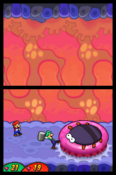
This time around, a mysterious disorder called "the blorbs" is causing excessive bloating in toads throughout the Mushroom Kingdom. In order to address the issue, Peach calls a meeting but doesn’t invite Bowser. When Bowser finds out he becomes irate, attempts to steal the princess, and is quickly kicked out of the castle by Mario. When Bowser wakes up, he is in a mysterious forest where he buys a strange food item from a shady vendor, who actually turns out to be the antagonist of this title. The "Lucky Mushroom" brainwashes Bowser and he promptly goes back to the castle and inhales everyone within the room. When Bowser eventually snaps out of his hypnotic state he realizes that Mario and Luigi are in fact stuck inside of him, and that both of them can work together to take out the evil mushroom vendor and his minions.
Mario & Luigi: Bowser's Inside Story features many similarities to its predecessors, yet firmly establishes its own identity. The classic cast of characters once again makes an appearance, and in typical Mario RPG fashion, enemies are forced to work together.
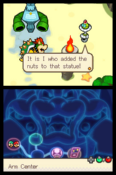
Like many of the other titles in the series, the introduction tends to be a little sluggish, focusing on a storyline that could have been shortened. Players are also spoon-fed the game’s controls via ongoing demonstrations well into the game. When players can finally stand on their own feet, they will explore countless unique environments on land and within Bowser. The graphics are similar to those of Partners in Time; the classic colorful Mario world combined with hints of detail to brighten and liven the experience. Complementing the scenic worlds is a wonderful soundtrack full of remixed classic favorites as well as brand new compositions.
While the music, gameplay, and characters may all be very similar to past Mario RPG titles, the gameplay has been switched up significantly, taking place in two distinct areas: Mario and Luigi stuck in Bowsers gut, and Bowser trudging around in the actual world. Players will need to switch between the two areas and player sets throughout the game in order to progress. This dynamic switch creates the biggest difference between the other handheld Mario RPG titles as the gameplay no longer revolves around just the brothers themselves. The game utilizes the DS’ two screens to show Bowser’s world on the top and Mario and Luigi’s on the bottom.

The greatest feature of this title is the constant interaction between Bowser and the brothers. Neither group is ever forgotten in the gameplay, as events that occur in one area almost always affect the other. There are countless interactions, but one of my favorites early on was raising and lowering the water level.
In a particular situation, Mario and Luigi become trapped within an area with ledges far too high for them to reach. So in order for them to get up high enough, players will switch to the top screen and make Bowser drink some water. This effectively raises the water level and allows Mario and Luigi to continue onward. As the level progresses, players will need to raise and lower the water several other times, so players must continually keep Bowser and his thirst in mind.
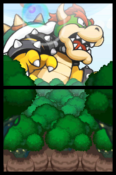
There were several other instances that I truly enjoyed including killing a monster blocking Bowser's fire pipe and defeating a parasite which is giving Bowser a terrible stomachache. These are only a few of the unique interactions that players will encounter early on in the game.
Many actions Mario and Luigi complete within Bowser will even allow him to perform special feats. For example, when Bowser needs to throw something heavy, Mario and Luigi proceed to the Muscle Center, where after a fun mini-game, manage to power up Bowser enough to lift the incredible object and send it flying.
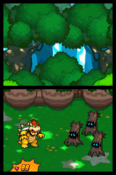
While this interaction is by far the best part of the game, the excellent RPG gameplay still remains, providing yet another experience for players to enjoy. Pacing has always been the key to a great Mario RPG, and Bowser's Inside Story stays true to that principal. Players will certainly find themselves challenged at particular points, however strategy always prevails over brute force power gained by grinding. As long as players diligently tackle every enemy they come in contact with, grinding will not be a necessity until much later on in the game, an expected staple of the series.
It's hard to find anything wrong with this title, and to be quite honest, I can't. The dual interaction is incredibly fun and firmly holds the players attention, the RPG element is wonderfully paced so it never becomes tiresome, the game itself is gorgeous and full of wonderful music, and the humor is witty and charming. In addition, there are countless other little touches that really make this game something special.
Bravo to Nintendo for yet another masterpiece, after so many sequels, they have still managed to create something fresh, unique, and as full of wit and appeal as the very original for the SNES.







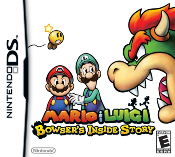


Comments